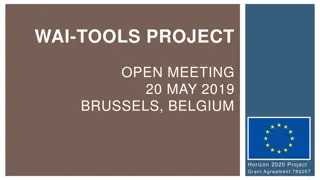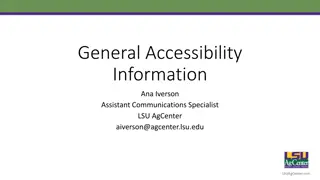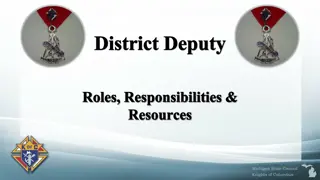Strategically Leveraging High-Level Support for Accessibility in Community Meetings
Explore insights shared by a US Department of Labor IT leader on leveraging top-level support for accessibility initiatives. Learn how to navigate conditional support, maintain executive sponsorship, and set clear expectations. Discover strategies for engaging key stakeholders and achieving initial success in promoting accessibility within organizations.
Download Presentation

Please find below an Image/Link to download the presentation.
The content on the website is provided AS IS for your information and personal use only. It may not be sold, licensed, or shared on other websites without obtaining consent from the author.If you encounter any issues during the download, it is possible that the publisher has removed the file from their server.
You are allowed to download the files provided on this website for personal or commercial use, subject to the condition that they are used lawfully. All files are the property of their respective owners.
The content on the website is provided AS IS for your information and personal use only. It may not be sold, licensed, or shared on other websites without obtaining consent from the author.
E N D
Presentation Transcript
Accessibility Community Meeting Getting the Support You Need: Strategically leveraging high-level support
Meet your presenter US Department of Labor Branch Chief of IT Quality Management Office of the CIO Approximately 18,000 employees nationwide 27 mission Agencies of various sizes 450 offices across the US & its territories
Background Started my career in the automotive industry Went from manufacturing to IT procurement and Indirect Materials Management Joined DOL in December of 2009 as a COR Held several leadership positions, ending with Quality Management Asked to stand up a Section 508 Program Office
Clarification I am NOT an accessibility expert. I am an evangelist for Section 508 and accessibility. My expertise is in: Lean concepts Continuous process improvement Communication and change management
Be cautious with top-level support! The DOL Deputy Secretary mandated creation of a Section 508 Program Office Support can be conditional Support is often spontaneous and lacks commitment You need an Executive Sponsor s authority but control their involvement! I set simple, clear expectations for our Assistant Secretary for Administration & Management (ASAM)
Two asks of our ASAM 1. Make it clear to the other Assistant Secretaries that the DepSec said to do this. (Suggested they bring concerns to him, not the DepSec.) 2. If an agency comes to him, ask, What did Brandon say about it? If they haven t talked to me, then send them my way. If they HAVE talked to me, just schedule a meeting for the three of us and I ll be there to do the talking.
Defining initial success Cited a higher authority by using OMB s Section 508 Maturity model 1. Using an existing structure gave immediate credibility to the plan. 2. Allowed me to bring attention to the need for process improvements. 3. Set us up for continued improvements because metrics help us: Pinpoint problems Measure the effectiveness of solutions Track our overall progress
Building executive trust Set a clear vision and aggressive but attainable goals. Under-promise and over-deliver along the way. Take a lesson from comedy improv: Never say no. Always take the yes and approach.
Summary so far Do NOT expect your top leadership to fight your battles for you. Try to keep the right authority as the backdrop to what you re doing, without ever having those authority figures argue your case for you. Convince them to never discuss counterpoints unless you re involved.
Critical: Clear Accountability! Our Section 508 Points of Contact had no authority in their agencies. DepSec mandated each DOL Agency appoint an Agency 508 Officer: Authority to speak on behalf of the agency Authority to communicate to agency personnel Access to the top Agency leadership Does NOT need to be a Section 508 expert Accountable for Agency support of the Section 508 Program Office
Winning Formula Get someone at the top of your organization to: Set clear lines of accountability within your various mission areas Refuse to listen to complaints Let you run with it! Do NOT expect your executives or politicals to argue on your behalf. The IMPLIED threat of their authority is more powerful!
Questions? Comments? (Snide Remarks?)
Set a grand vision Brandon s 508 Vision: DOL no longer views accessibility as a roadblock and something we have to do because it s the law. We make sure everything is accessible; and every person at the Department creates accessible work products because that s how we do it here. All employees embrace the fact that accessibility is a non-negotiable and it s everyone s responsibility. Problem: This requires MASSIVE change to our organizational culture!
Problem: Focus on remediation People want to create something and hand it off for remediation. Remediation is synonymous with accessibility. Told stories to help people understand that accessibility is fundamental.
Problem: Focus on remediation, cont. Began equating remediation with poor quality. Remediation is REWORK, which is one of the seven forms of WASTE! No manager is paying their people for poor quality work! Remediation is part of the failure stream and you don t optimize for failure you focus on first time quality, which ALWAYS includes accessibility!
Problem: Pleading ignorance My people don t know how to do accessibility, says every manager everywhere! During mandatory training for supervisors, I challenged them to simply do 3 things: 1. Stop passing the buck! 2. Stop defending ignorance! 3. Ask one simple question: Is it accessible?
Training to touch hearts Awareness training was built around a truthful story because people remember stories better than lectures. Example: Main character s cousin uses a wheelchair and must go down the alley, past the dumpster, and down a dingy hallway to enter the restaurant. People now picture THAT scene when they think of disabled persons struggling to access our ICT!
ADKAR Model of Change Management Awareness: Make the person aware for the needed change. Desire: Create in the person a desire to make the needed change. Knowledge: Give the person the knowledge to make the change. Ability: Help them turn knowledge into skills to make the change. Reinforcement: Create processes that reinforce the changes made.
Reinforcement is key DOL is tackling Reinforcement in two critical ways: Encourage the question, Is it accessible? Promote reinforcement by asking all supervisors to begin holding their direct reports accountable for accessibility. Focus on process review and improvement. Build accessibility into workflows and include measurement and reporting of accessibility.
Establish responsibility AND accountability DOL Policy states whoever PAYS for the ICT is accountable for accessibility. Budget holder can delegate responsibility but NOT accountability. DOL Agencies don t like it but it has kept them much more actively involved in ensuring ICT is accessible!
A long way to go Give a man a fish, and you feed him for a day. Teach a man to fish, and you feed him for a lifetime. Our team is too small to enforce Section 508, so we re creating a culture where we don t have to. People are paying attention and the culture truly is changing!
Questions? Comments? (Snide Remarks?)
We have a foundation Stories from the 508 trenches indicate an uphill battle. DOL has pockets of excellence in its IT development. Excellent foundation in policy and acquisitions: Well-established IT Accessibility Policy All IT contracts required to have Section 508 boilerplate provision
Force begets force When you push someone, the always push back! Past failed attempts at Section 508 focused on enforcement. Someone in leadership thinks fixing them problem just takes a strong demand and a big stick to make people comply. Instead, we want to calmly steer people where we want them to go!
Messaging is critical Be clear and consistent with your messaging. Leadership often wants simple answers but this is a complex problem. Don t bore them with the details - communicate concepts they need to know: Create messages they understand Hammer those messages relentlessly
My big three messages Accessibility is a QUALITY issue. Remediation = Rework = WASTE There are three IT "non-negotiables": 1. Privacy 2. Security 3. Accessibility Crafted for brevity and to ANCHOR accessibility to something they understand.
Its a QUALITY issue Quality is no longer a differentiator - it's a given. Be ready for pushback like, "Define accessible." Standards are well-defined. I ll send you a link. Or What if our people don't know how to do it?" Send them to us and we ll help them figure it out. You can t INSPECT or TEST quality into a product or service!
Remediation is WASTE People understood once I linked remediation to WASTE. True Story: An Agency paid a lot for training materials and asked us to remediate them! Our ASAM understood "remediation is waste" and would tell other Agency heads to Stop generating so much waste!" He didn't need to understand accessibility to defend this position because I had anchored REMEDIATION to the concept of WASTE.
3 IT Non-Negotiables Security - link to the importance but NOT to the perceived budget! Privacy - critical in the minds of enforcement agencies Accessibility - it s the law, so it s obviously a non-negotiable
Messages for the masses Selected two messages that are less strategic : 1. Accessibility is EVERYONE S responsibility! 2. Fix your process and the outcomes will take care of themselves. We don t police everyone; we help them learn to do the right thing. We re training everyone we can, as fast and as thoroughly as we can!
Reframe the purpose of metrics DOL has plenty of lagging metrics, often used to determine blame. Our goal is to help supervisors create standardized processes and then measure them properly: Don t start with remediation (outcomes); fix the process. Institute leading metrics to proactively identify problems. Implement a solution, test its effectiveness, rinse, repeat!
OMB Maturity Model Fits Five logical areas for Continuous Process Improvement: 1. Acquisitions 2. Tech Lifecycle 3. Testing and Validation 4. Training 5. Complaint Management We ask for PROGRESS, not perfection!
Play an Infinite Game! Some Section 508 veterans disagree with me: Long-term vision is too grand Short-term expectations are too little, too late This is NOT a finite game, where someone wins and someone loses. This is an INFINITE game play to keep playing!
Lets connect! Brandon Jubar Jubar.Brandon.T@DOL.gov (202) 693-4289 LinkedIn.com/in/brandonjubar/
Questions? Comments? (Snide Remarks?)























